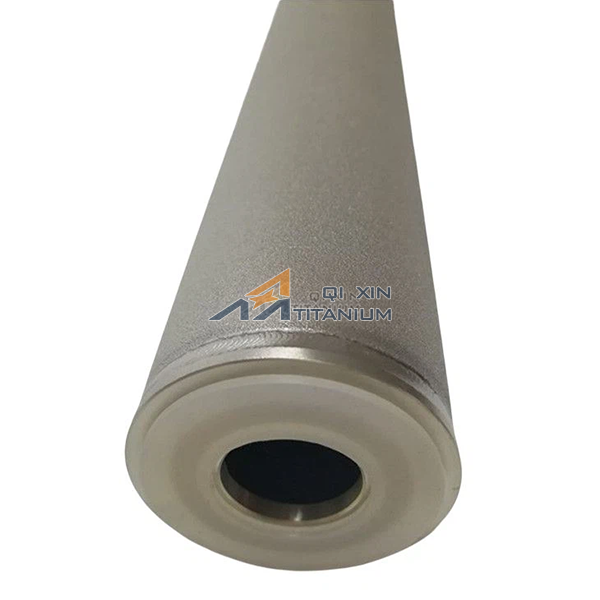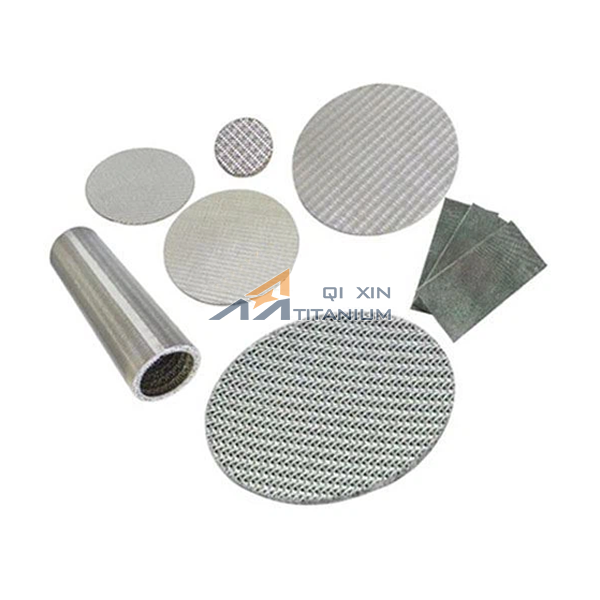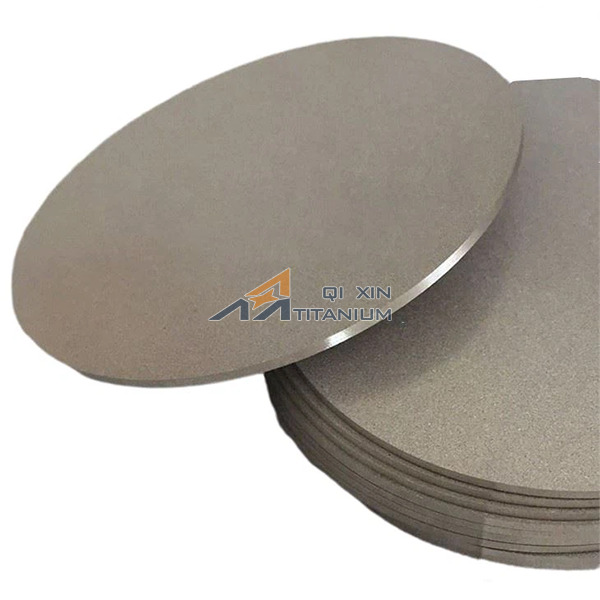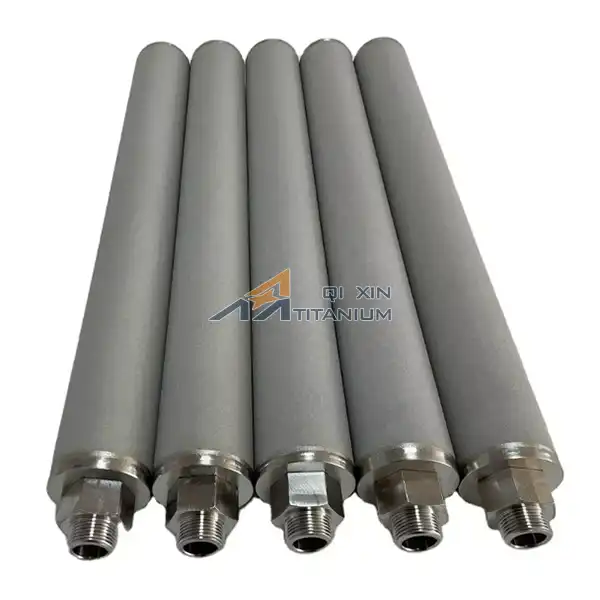How are sintered metal powder filters manufactured?
2025-03-31 10:54:17
Sintered metal powder filters are manufactured through a sophisticated process that combines precision engineering with advanced materials science. The production begins with the careful selection of metal powders, typically including stainless steel, bronze, or titanium. These powders are then mixed to achieve the desired composition and properties. The mixture is poured into molds and subjected to high pressure and temperature in a controlled environment. This sintering process causes the powder particles to fuse together, creating a porous yet strong structure. The resulting filter is then cooled, trimmed, and finished to meet specific requirements. This method allows for the creation of filters with precise pore sizes and distributions, making sintered metal powder filters ideal for applications requiring high-performance filtration in extreme conditions.
The Intricate Process of Sintered Metal Filter Powder Production
Raw Material Selection and Preparation
The journey of creating a high-quality sintered metal powder filter begins with the careful selection of raw materials. Manufacturers choose metal powders based on the intended application of the filter, considering factors such as corrosion resistance, temperature tolerance, and mechanical strength. Common materials include stainless steel, bronze, nickel, and titanium alloys. These powders are meticulously screened and sorted to ensure uniform particle size distribution, which is crucial for achieving consistent pore size in the final product.
Powder Blending and Additive Incorporation
Once the appropriate metal powders are selected, they are blended in precise ratios to achieve the desired properties of the final filter. This step may also involve the addition of binding agents or pore-forming materials to enhance the filter's performance characteristics. The blending process is carefully controlled to ensure homogeneity throughout the mixture, as any inconsistencies can lead to weak points or variations in filtration efficiency in the finished product.
Mold Preparation and Powder Loading
The next stage involves preparing the molds that will shape the sintered metal filter powder into its final form. These molds are designed with great precision to account for the shrinkage that occurs during the sintering process. The metal powder mixture is then carefully loaded into the molds, ensuring even distribution and compaction. This step is critical in determining the final shape and dimensional accuracy of the filter.
High-Temperature Sintering: The Heart of the Manufacturing Process
Initial Compaction and Green Body Formation
Before the high-temperature sintering begins, the powder-filled molds undergo an initial compaction process. This step, often performed at room temperature or slightly elevated temperatures, creates what is known as a "green body." The green body is a fragile, partially compacted version of the filter that holds its shape but lacks the strength and porosity of the final product. This intermediate stage is crucial for achieving the desired density and pore structure in the finished filter.
Sintering Process and Temperature Control
The core of the manufacturing process lies in the high-temperature sintering stage. The green bodies are placed in specialized furnaces where they are heated to temperatures just below the melting point of the metal powder. This heat treatment causes the metal particles to fuse together at their contact points, creating a solid, porous structure. The sintering temperature and duration are precisely controlled to achieve the desired level of particle bonding and pore formation. For high-temperature sintered powder metal filters, this stage is particularly critical, as it determines the filter's ability to withstand extreme thermal conditions in its final application.
Cooling and Dimensional Stabilization
After the sintering process, the filters enter a controlled cooling phase. This step is crucial for maintaining the structural integrity of the filter and preventing warpage or cracking. The cooling rate is carefully managed to allow for proper crystallization and stress relief within the metal structure. As the filters cool, they undergo slight dimensional changes, which are accounted for in the initial mold design to ensure the final product meets the specified dimensions.
Post-Sintering Treatments and Quality Assurance
Surface Finishing and Pore Size Calibration
Once cooled, the sintered metal powder filters undergo various finishing processes. These may include machining to achieve precise dimensions, surface treatments to enhance corrosion resistance, or additional heat treatments to optimize mechanical properties. For filters requiring extremely precise pore sizes, techniques such as chemical etching or laser perforation may be employed to fine-tune the filtration characteristics.
Performance Testing and Quality Control
Rigorous testing is an integral part of the manufacturing process for sintered metal filter powder products. Each filter undergoes a battery of tests to ensure it meets the required specifications. These tests may include bubble point tests to verify pore size distribution, flow rate measurements to confirm filtration efficiency, and pressure drop tests to assess the filter's performance under operating conditions. Additionally, microscopic examination and materials analysis are often performed to verify the structural integrity and composition of the filter.
Packaging and Documentation
The final stage of the manufacturing process involves proper packaging to protect the filters during transportation and storage. Each filter is typically accompanied by comprehensive documentation, including test results, material certifications, and traceability information. This documentation is crucial for quality assurance and regulatory compliance, especially for filters used in critical applications such as aerospace, medical devices, or chemical processing.
Conclusion
The manufacturing of sintered metal powder filters is a complex process that combines advanced materials science with precise engineering techniques. From the careful selection of raw materials to the high-temperature sintering process and rigorous quality control measures, each step is crucial in producing filters that meet exacting standards of performance and reliability. The resulting products are capable of withstanding extreme conditions while providing consistent filtration efficiency, making them invaluable in a wide range of industrial and technological applications. As manufacturing techniques continue to evolve, we can expect even more innovative and high-performance sintered metal powder filter solutions to emerge, further expanding their utility across various sectors.
Contact Us
To learn more about our sintered metal powder filters and how they can benefit your specific application, please don't hesitate to contact our expert team at Qixin Titanium Co., Ltd. We're here to provide you with tailored solutions and unparalleled customer support. Reach out to us today at info@mmo-anode.com to discuss your filtration needs and discover how our advanced manufacturing processes can deliver the high-quality filters your operations demand.
References
Johnson, R. M., & Smith, K. L. (2019). Advances in Sintered Metal Powder Filtration Technology. Journal of Materials Engineering and Performance, 28(3), 1532-1541.
Zhang, Y., & Liu, X. (2020). High-Temperature Performance of Sintered Powder Metal Filters in Aerospace Applications. Aerospace Science and Technology, 98, 105659.
Brown, A. C., et al. (2018). Optimization of Pore Size Distribution in Sintered Metal Filters for Enhanced Filtration Efficiency. Powder Technology, 331, 409-417.
García-Martínez, J., & Li, K. (2021). Recent Developments in Sintered Metal Membrane Technology. Chemical Engineering Science, 229, 116135.
Thompson, D. R., & Wilson, S. (2017). Sintered Metal Powder Filters: Manufacturing Processes and Material Selection. Materials & Design, 128, 69-85.
Lee, H. S., & Park, J. Y. (2020). Corrosion Resistance of High-Temperature Sintered Powder Metal Filters in Aggressive Environments. Corrosion Science, 163, 108290.
Send Inquiry
Related Industry Knowledge
- How are sintered porous metal filters manufactured?
- How do you clean or maintain a sintered metal filter tube?
- Choosing the Right Sintered Metal Filter Plate for Your Filtration Needs
- Sintered Metal Powder Filter Cartridges: Durability, Efficiency, and Customization Options
- Versatile Applications of Electrolyzed Water Titanium Mesh Electrodes
- Maintenance and Longevity of MMO Coated Titanium Anodes
- What materials are sintered metal candle filters made from?
- How to Use an Air Stone Disc Bubble Diffuser in an Aquarium?
- What is Sintered Metal Filter Disc?
- What are sintered metal powder filters made of?





